Departments
Search
Follow Us
Tags
Latest Highlights
IBH
A short history of knitting
Since I’ve been an enthusiastic knitter for years I was interested in learning something about the origins of this wonderful craft. I hope you enjoy reading what I found out.
Very little is known about when and where people began to knit because knitting is made of organic fibers like wool and silk that decay rapidly. So the oldest archeological finds of knitted clothes in the Middle East originate from early post-Christian times. From the Middle East knitting techniques spread to Spain. The earliest knitted items in Europe were probably made by Muslim knitters that were employed by noble Spanish families.
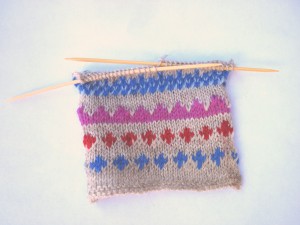 From Spain knitting spread to the whole of continental Europe during the Middle Ages and by the 12th century it was already an advanced craft. The first knitters‘ guild was founded in Paris in the 13th century, followed by similar organizations in other European countries. Knitting was mainly a male occupation at this time and only men were admitted to the guilds. The knitters‘ apprenticeship lasted at least seven years.
From Spain knitting spread to the whole of continental Europe during the Middle Ages and by the 12th century it was already an advanced craft. The first knitters‘ guild was founded in Paris in the 13th century, followed by similar organizations in other European countries. Knitting was mainly a male occupation at this time and only men were admitted to the guilds. The knitters‘ apprenticeship lasted at least seven years.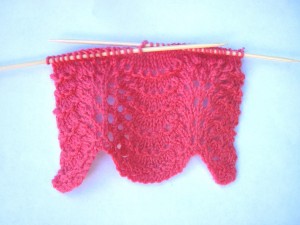
It was not until the 15th century that knitting reached Britain. During the next hundred years an active knitting industry developed here. Queen Elizabeth I, who was queen of England from 1558 until 1603, passed a large number of laws and regulations to support and protect this trade. She ordered for example that on Sundays and Holy days every male over the age of six had to wear a woolen cap made in England.
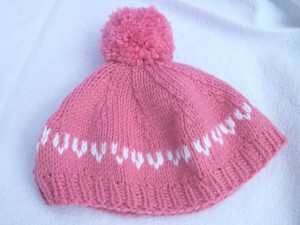 In 1589 William Lee, an English clergyman, invented the first stocking frame knitting machine. He applied for a patent from Queen Elizabeth, but she denied his request because she thought it would ruin the hand knitting industry. Nevertheless the number of knitting machines employed in different parts of the country gradually increased over the next two centuries and hand knitting could no longer compete with these.
In 1589 William Lee, an English clergyman, invented the first stocking frame knitting machine. He applied for a patent from Queen Elizabeth, but she denied his request because she thought it would ruin the hand knitting industry. Nevertheless the number of knitting machines employed in different parts of the country gradually increased over the next two centuries and hand knitting could no longer compete with these.
Commercial hand-knitting only survived in the coastal areas of England, Scotland and Ireland, but in most parts of Europe and America hand-knitting became more and more a domestic and now predominantly female occupation and especially popular in the 19th century among women of the new urban middle class.
In the 1830‘s the first women’s magazines were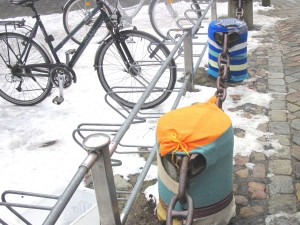 published which contained patterns and instructions for knitting and sewing as well as popular literature and recipes. In the Victorian era knitting was used to make all sorts of mainly decorative items. In the first half of the 20th century and especially during the World Wars mainly practical reasons compelled women to knit. In the last third of the century, when the role of women changed considerably, knitting was seen as a stuffy hobby for grannies.
published which contained patterns and instructions for knitting and sewing as well as popular literature and recipes. In the Victorian era knitting was used to make all sorts of mainly decorative items. In the first half of the 20th century and especially during the World Wars mainly practical reasons compelled women to knit. In the last third of the century, when the role of women changed considerably, knitting was seen as a stuffy hobby for grannies.
The last ten years have brought a real resurgence of knitting which is no longer considered boring. Today’s knitters sometimes use traditional techniques to create real works of art. A special form of knitted art is guerrilla knitting which started 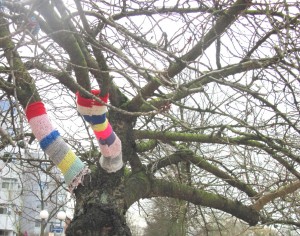 in Houston in 2005 and has since spread worldwide. It means that knitters stitch colorful cozies for everything in the streets: trees, bike racks, benches, statues and even cars and buses. The photos above show modest examples of guerrilla knitting in the small town where I live.
in Houston in 2005 and has since spread worldwide. It means that knitters stitch colorful cozies for everything in the streets: trees, bike racks, benches, statues and even cars and buses. The photos above show modest examples of guerrilla knitting in the small town where I live.
Tags: Handmade, Handmade Artists, handmade knitting, knitted bonet, knitted tree, knitting, the history of knitting
Posted in Handmade
3 Responses to “A short history of knitting”
Leave a Reply
You must be logged in to post a comment.


Thanks for the history lesson, what a great read! Shared 😀
great story…I’ve seen some amazing guerilla knitting photos on line. Who has time for that? lol
Debbi
–yankeeburrowcreations
I love to knit, and those Guerrilla Knitting things are a hoot, we have some show up in Boise occasionally. Great article.